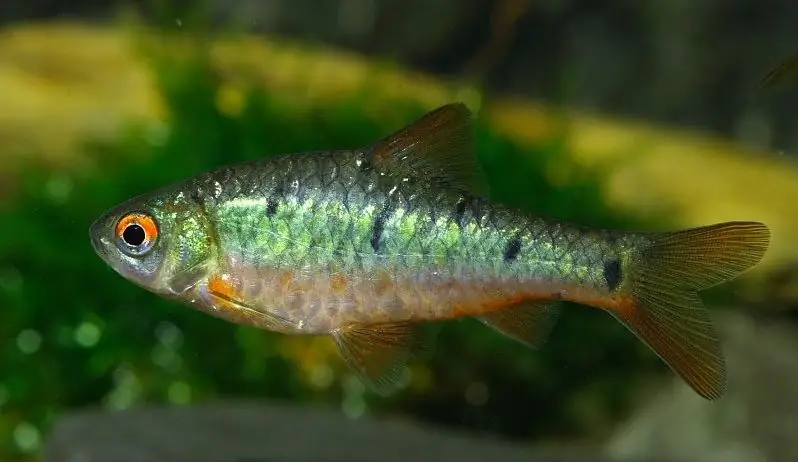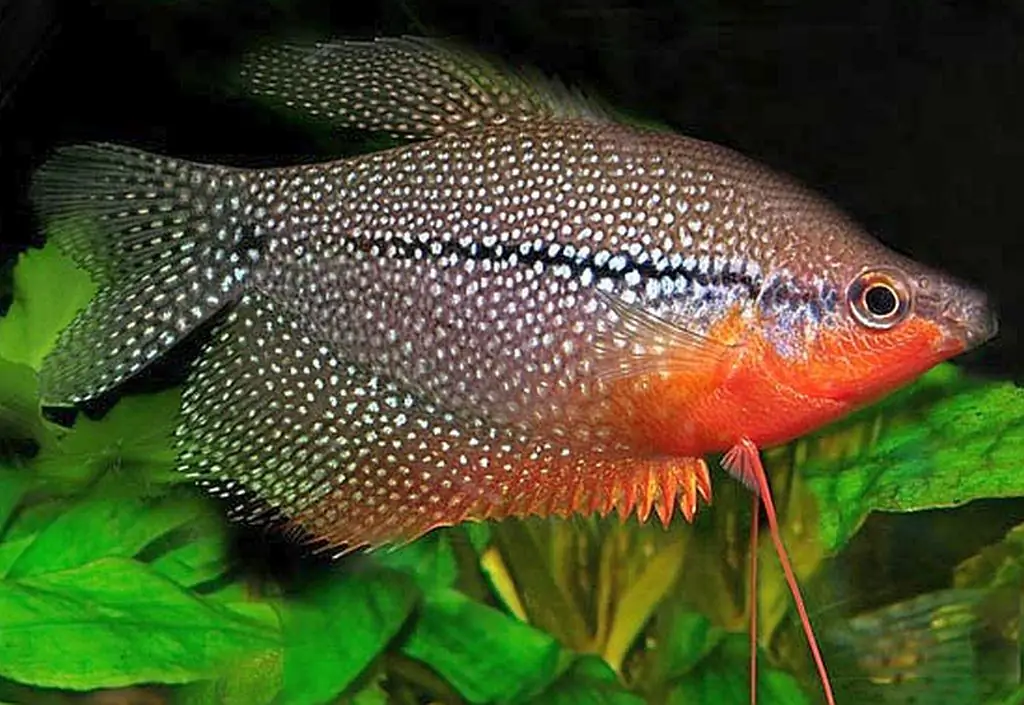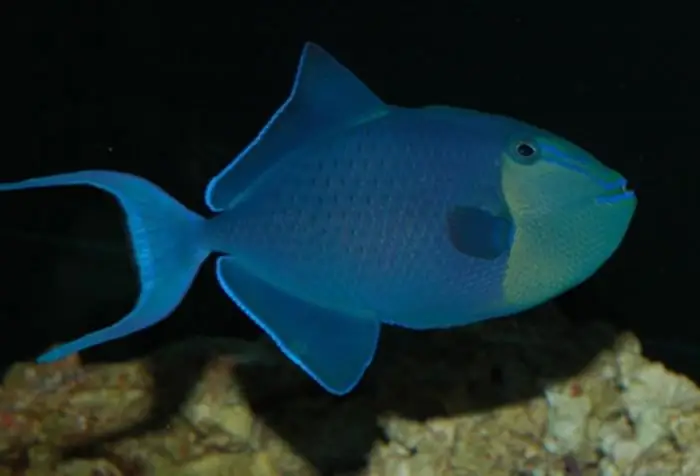2025 Author: Priscilla Miln | [email protected]. Last modified: 2025-01-22 17:55:16
Sumatran barb fish has been very popular with aquarists for a long time. It is quite unpretentious regarding the quality of water and food. In addition, it is a pleasure to follow a flock of tiger barbs, they are constantly on the move. Pretty willing to breed even in inexperienced aquarists.
Habitat

In the wild, the Sumatran barbus lives in the waters of Southeast Asia. It is found in Thailand, Malaysia, Indonesia. Of course, there is it in Sumatra. That is why the fish got its name.
In European countries, these pets have been started since 1935. A decade later, they reached Russia.
Description
Barbus belongs to the carp family. In the aquarium, its length reaches four to five centimeters, although there are individuals as large as seven centimeters. Female Sumatran barbs are larger than their companions of the opposite sex.
The body is laterally flattened, elongated. They don't have whiskers. The tail is forked. Eyes round withbig black pupils.
Color

The classic color of the Sumatran barb is presented in the form of light scales. It has four vertical stripes of dark color:
- The first strip passes through the eye, merging with the pupil.
- The second is located near the pectoral fins.
- The third one runs just behind the dorsal fin, which is also colored black but has a reddish edge.
- The fourth is located in front of the tail fin. She is the shortest.
Stripes are placed on both sides of the fish. It is for this color that it is often called brindle. The anterior part of the head is reddish in tone. The fins are either red or transparent. Representatives of aquariums have a richer color than individuals living in their natural environment.

Breeders have bred individuals of other colors. Green barbs look very nice. They also have four vertical stripes. But due to the fact that they are painted in a dark green tone, they are practically invisible on greenish scales. The fish resembles an emerald. You can also find gold, scarlet and other colors. There are also albinos. Their bodies are pink and their stripes are white.
Aquarium

Good conditions for the Sumatran barb require the acquisition of their flock. Therefore, the aquarium must be at least sixty liters. At the bottom it is better to place dark soilcolors because they are able to adapt to the environment. With light ground, they will turn pale, which will negatively affect the beautiful color.
Water should have a temperature in the range of 20-26 ° C, hardness - soft or medium, acidity - 6-7 units. The lighting is moderate. Water should be constantly filtered, provided with oxygen. Moderate fluid movement in the reservoir is also required.
It is necessary to replace them daily with up to 25% of water. If this is not done, nitrogenous compounds will accumulate in it. This will increase the risk of infectious diseases.
Under good conditions, Sumatran barbs will live for about six years. However, these figures are average, according to various sources, life expectancy ranges from three to seven years.
Plants
In the photo, the Sumatran barbus is more often shown at the bottom. It does not hurt to place a few plants on the surface. This will create shaded areas in the tank that are needed to increase comfort.
You can select all kinds of plants, depending on the wishes of the owner of the aquarium. It is worth placing densely growing plantings along the walls of the tank, and leave a place for swimming in the center. You can put snags, pieces of wood on the bottom.
Features of behavior

Fish actively and cheerfully swim together at the bottom and in middle waters. They like both dense thickets and free space. Therefore, the tank must have both. It happens that one Sumatran barb fights off the group andbecomes immobile. Do not immediately sound the alarm, they consider it the norm.
Food
Tiger barbs feed on all kinds of food. This is good, but leads to frequent overeating, which subsequently causes death. They can be given bloodworms, brine shrimp. Shredded lettuce leaves are suitable from vegetation. It is preferable to feed pets with specialized dry food.
Because of their greed for food, they often fumble around the feeder. As a result, fast and agile fish eat more, and slow fish often remain hungry.
How is Sumatran barb bred?
Breeding

For spawning, a couple of fish or two males and one female should be transplanted. Those who are engaged in breeding professionally prepare fish in advance. From the age of five months, they are separated by gender and kept in water at a temperature of +22 ° C. They are fed once a day. The menu is different every time. Future producers should not be obese.
Then females are selected that have swelling in the front of the body. The male Sumatran barb should be active and brighter than the others. It is better for the couple to be from different family lines.
If all the fish lived in the same aquarium, they should be separated from each other for at least a couple of weeks. Next, spawning is being prepared.
For one pair, a tank of six to fifteen liters is enough. The soil does not need to be placed. It is necessary to lay a separator mesh on the bottom. Eggs will fall under it. also inthe tank will need java moss. A synthetic washcloth can replace it. When forming a spawning ground, it is extremely important to maintain cleanliness. Interior walls and all synthetic components should be washed with baking soda.
The tank is filled with water, which should be half of the old aquarium and a quarter of fresh, but separated. The last fourth part of the spawning area is filled with distilled water. The temperature in the tank should be +25-28 °С.
The fish are placed in the spawning area in the evening. Breeding should begin in the morning, which will take two to three hours. The process will be stimulated by adding water to the tank, which was taken from the spawning ground of another pair. However, no more than a day should pass, otherwise this liquid will not work.
You don't need to feed pets in the spawning ground. The process looks like this. The male chases after his "lady" and knocks the eggs out of her abdomen with short blows. The breeding process occurs several times with an interval of one week. Both sexes should be kept in separate tanks between spawnings. If the female carries eggs, she must sweep them. Otherwise, it may form cysts. Neoplasms are also formed if the female did not sweep all the eggs. The reason for this may be the low activity of the partner or a close spawning ground. The female dies in most cases.
You can fix the situation with your own hands. To do this, the female must be taken out of the tank, laid on wet cotton wool and the eggs are drained, making gentle movements with the fingers along the abdomen. Of course, this is an unsafe business and requires incrediblepatience, but otherwise the fish cannot be saved.
Caring for young animals
For one spawning, the female lays four hundred to eight hundred eggs. After that, the parents are suspended. And in the spawning tank, a third of the water is replaced with settled water. It is recommended to tint it with methylene blue to a bluish tint. The tank is then shaded. It is important that sunlight does not fall on the caviar. Water must be aerated. If there is a lot of caviar, aeration should be maximum.
The incubation period is one to two days depending on the water temperature. The emerging larvae hang on the walls of the tank for several days. They feed on the yolk sac. When it resolves, they begin to swim. Then they need food. For starters, “live dust” is suitable. After a week, you can add microfeed to the diet. Water should be changed by a third every day. Then the young will grow more intensively.
At the age of two weeks, the fry grow to one centimeter. Vertical stripes appear on their body. The color of adults will appear in them in another one to two weeks. Juveniles need to be fed abundantly and varied.
Young fish will reach sexual maturity by eight to twelve months. Interestingly, albinos breed the worst. One of the parents must be with the usual color. As a result, only 25% of all offspring will be albinos. Most of them die at a young age due to the slightest deviations in care.
Compatibility

For tiger barbs to coexist peacefully with each other and with othersinhabitants of the aquarium, there should be six to twelve individuals in a flock. Then they will swim calmly, knowing that they will fight off a possible threat. If there are about five fish, conflicts within the group will begin.
Sumatran barb, the compatibility of which is being considered, does not apply to predatory. But fry are another matter. Representatives of cyprinids will hunt for young animals until they are all caught. Therefore, spawning in a tank with these minke whales is not worth it.
All slow-moving veil fish species do not suit them as neighbors. A flock of barbs will make them uncomfortable with their playful behavior. They also like to bite the tips of their long fins and whiskers. Therefore, goldfish and gourami will not be happy with their company.
They should be settled with the same active non-aggressive fish.
Recommended:
Large aquarium fish: names, description with photo, compatibility and content rules

Thousands of species of fish live in the waters of the earth's seas and oceans, in rivers and lakes of the continents. Amateur aquariums contain not only wild species, but also those modified by humans through selection and hybridization. Moreover, fish farmers do not refuse to admire not only delicate bright small handsome fish. Large aquarium fish also arouse their passionate interest
Aquarium fish gourami pearl: description, content, compatibility, breeding

The aquarium world is bright and varied. What kind of creatures you will not meet at the bottom of the home "ocean"! One of the brightest representatives of the inhabitants of the underwater kingdom is the pearl gourami - a brilliant fish in all respects
Acara turquoise: photo, content, compatibility with other fish in the aquarium

Turquoise akara is famous not only for its magnificent view. In the West, it is often called "green horror". This is due to its aggressiveness towards other inhabitants of the aquarium. But this does not mean that the fish should live alone. The task of the owner is to create optimal conditions for individuals of this species, to add suitable fish to them. Then there won't be any problem
Fish domestic. Types of aquarium fish, compatibility and content

There are several thousand varieties of aquarium fish in the world. Small and large, predatory and carnivorous, bright and not very bright, with lush tails, long mustaches and bizarre fins - all these inhabitants of the underwater world attract with their beauty, and watching their unhurried movements in the water column helps to relax and take a break from everyday problems
Fire barbus fish: photo, breeding, maintenance

Fiery barbus is an aquarium fish of the cyprinid family, which conquered European hobbyists in the twentieth century. Beginners like it for its unpretentiousness, and knowledgeable aquarium owners appreciate its peaceful disposition. The fish is also called puntius. Why is it called fiery? You can learn about this and much more from the article

